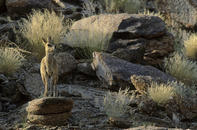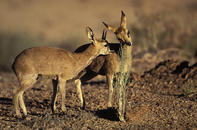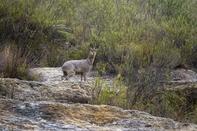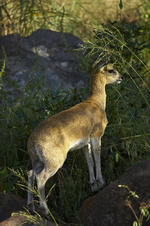Rocky Antelope
‘Klip’ means rock and ‘springer’ means jumper in Afrikaans and they are descriptive of this antelope’s rocky habitat and its exceptional agility moving over such terrain. Klipspringers are distinctly golden in colour but have a rough appearance.

The hairs of the coat are generally pale but are individually tipped with colour that gives the coat its golden sheen. It is grizzled with black as a result of darker bands on the hairs. The nature of the coat provides effective camouflage amongst the rocks. Klipspringer have unique feet amongst ungulates.
They actually walk on the tips of their hooves and their spoor impress as two round marks, the heart-shape facing the reverse direction to normal, i.e. the thicker edge faces forward. The hooves are essentially cylindrical with blunt tips. They are rimmed on the inside edge with a cartilaginous pad.
This arrangement specifically modifies the feet for bounding unhindered up steep rock faces and from boulder to boulder. The hooves provide traction and grip, absorb the shock of each landing and enable klipspringer to change direction suddenly.
Monogamous for Life

Klipspringer form monogamous pairs, one male and one female exclusively, and remain together in a mutual territory. It is rare for mammals to form long-term monogamous alliances and only 5% of them do so.
Klipspringer live in a very specific habitat. Rocky areas almost form islands amongst other inappropriate habitat and it can be extremely difficult and risky to find a mate. It, therefore, makes sense for them to team up with a partner for life. In this manner, the effort of securing a mate with which to breed is limited to the first occasion only.
Thereafter, the pair can focus their energy on defending an area with good resources and raising young. Klipspringer pairs are seldom far from one another and they even rest lying touching one another.
Not Water Dependent

Klipspringer usually nibble from different plants as they forage seldom focusing on a single plant unless it is in fruit or flower. In such cases, they will deftly pluck the desirable parts of the plant without damage to the rest of it. They may stand on their hind legs to access food up to 1.2 m high. Remarkably klipspringer favour the extremely toxic rubber euphorbia tree.
They supplement mineral deficiencies, usually calcium and phosphorous, in their diet by practising both osteophagia - chewing of bones, and geophagia - chewing of soil, in this case accessed from termite mounds. They will drink from rock pools after rain but are not water-dependent.
Quick Facts

50-60 cm
Weight
10-15 kg (female larger)
Lifespan
15 years
Habitat
Rocky hills and outcrops
Gestation
6-7 months
Number of young
1
Food
Browser
Predators
Leopard, hyena, caracal, baboon, black and martial eagles, lambs by jackal
By Megan Emmett